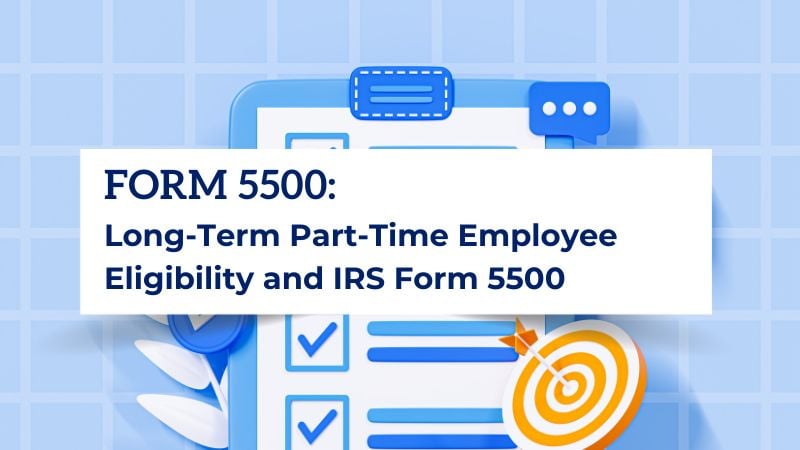Complying with SECURE Act Changes to Long-Term Part-Time Employee Eligibility and IRS Form 5500
Complying with SECURE Act Changes to Long-Term Part-Time Employee Eligibility and IRS Form 5500
Two significant regulatory changes to retirement plans require immediate attention from plan sponsors, both to ensure current operational compliance and to comply with upcoming deadlines. Many long-term, part-time (LTPT) employees are now eligible for 401(k) retirement plans; there is also a new method of counting defined contribution retirement plan participants on Form 5500 Annual Return/Report. It’s important to note that a retirement plan’s audit status could be affected as these changes take effect.
In addition to understanding the far-reaching implications that could help avoid missteps with LTPT employee eligibility and revised participant headcounts, we will explore how to correct any missteps that have already occurred.
New eligibility opportunities for long-term, part-time employees
Prior to the SECURE Act of 2019 and SECURE 2.0 Act of 2022 (collectively SECURE), employers could exclude employees from their tax-qualified defined contribution plans based on the number of hours they worked per year. Typically, this meant that part-time employees were ineligible to contribute to their employer’s retirement plan — no matter how many years they had worked for their employer. An IRS Employee Plans Newsletter issued on January 26, 2024, defined LTPT employees as workers who have worked at least 500 hours per year in three consecutive years, although the consecutive year condition will be reduced to two years in 2025.
SECURE expanded LTPT employee access to employer retirement plans by requiring 401(k) plans to allow employees that meet the LTPT requirements to make elective deferrals starting with the first plan year beginning on or after January 1, 2024. Employers are not required to make employer contributions for LTPT employees.
However, the burden of identifying, notifying, and enrolling these newly eligible LTPT employees falls on the employers. Failing to inform LTPT employees of their eligibility as of January 1, 2024, may have resulted in non-compliance. To rectify any compliance issues, employers can consider using the IRS amnesty program known as the Employee Plans Compliance Resolution System (EPCRS).
It is essential to understand this new requirement because LTPT employee eligibility may affect two other administrative functions for plan sponsors: Form 5500 filing and the annual employee benefit plan audit requirement.
A key change when counting participants for Form 5500
Prior to 2023, IRS Form 5500 — an essential part of ERISA’s reporting and disclosure framework — required defined contribution retirement plan sponsors to include employees who were eligible to make elective deferrals on the first day of the plan year. In most organizations, LTPT employees would be excluded from this headcount unless the employer’s plan allowed them to make contributions to the retirement plan.
Now, employers need only include participants with an account balance in the defined contribution retirement plan as of the first day of the plan year (but, for new plans, the participant account balance count is determined as of the last day of the first plan year). This may sound like a simple change, but the potential increase in participants who are LTPT employees complicates the matter.
The impact on a plan’s audit requirement
An organization’s obligation to have an annual audit of its retirement plan is dependent on the number of plan participants as of the first day of the plan year.
Beginning with the 2023 plan year, defined contribution plans that have more than 100 participant accounts as of the first day of the 2023 plan year generally must have an annual independent audit. Before 2023, all plan participants who were eligible to make salary deferrals were included in headcounts as participants even if they had not made any plan contributions. The DOL changed the rules starting in 2023 to include only those with account balances as participants. Keep in mind that the number of participants can be decreased by taking advantage of rules that allow distributions of small account balances (accounts valued at less than $7,000 starting in 2024) to former participants, if the defined contribution plan adopted these provisions.
The audit requirement of plans with 100 or more employees may change since employees without account balances are no longer counted. An organization may find that the defined contribution plan no longer requires an audit if eligible employees have not contributed to the 401(k) plan, but the audit requirement may be triggered when previously excluded LTPT employees begin to make elective deferrals.
Navigating the new normal for certain retirement plans
The LTPT employee rules take effect for plan years beginning on or after January 1, 2024 (for calendar-year end plans). If your organization missed the deadline to allow LTPT employees to participate in your plan, the good news is that there is a path to compliance. However, implementing these complicated changes in the law requires in-depth knowledge of the complex issues surrounding tax-qualified retirement plans. Experienced consultants can provide guidance and support throughout the process in the following ways:
- Analyze plan documents and employee data to identify any compliance gaps or issues that need to be addressed
- Engage in detailed discussions with plan sponsors to explain the intricacies of the changes and helping them understand the necessary steps to ensure compliance
- Facilitate communication with service providers to aid in a smooth transition and implementation of any required changes
- Calculate corrective actions required to rectify any non-compliance issues and confirm future compliance
- Guide the employer in enrolling in the IRS’s amnesty program (EPCRS), if necessary, to self-report non-compliance issues
- Help plan sponsors track the path taken to incorporate the necessary changes into the plan documents, to ensure ongoing compliance and avoid future issues
- Discuss Form 5500 preparation considerations, including participant head count

